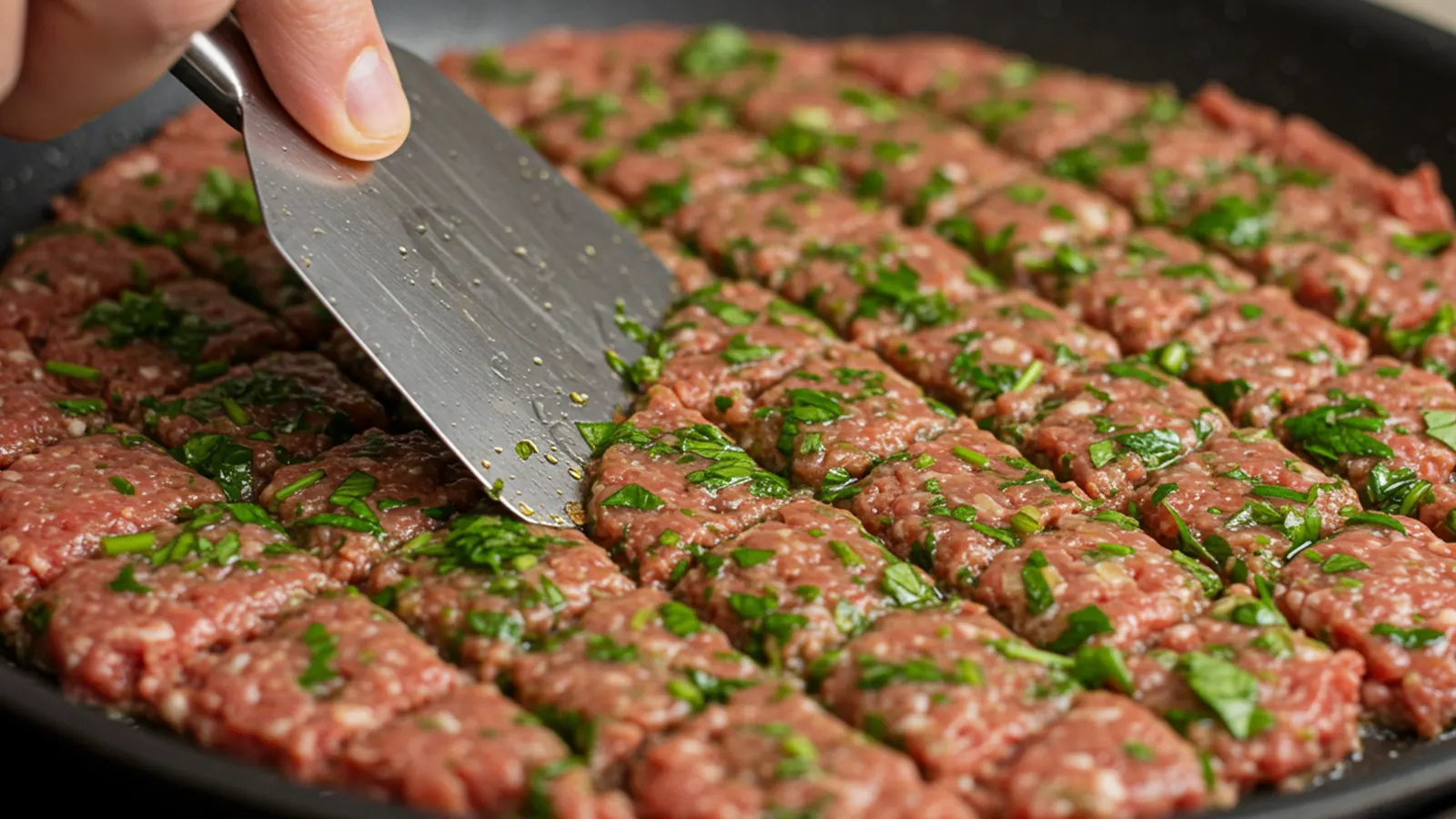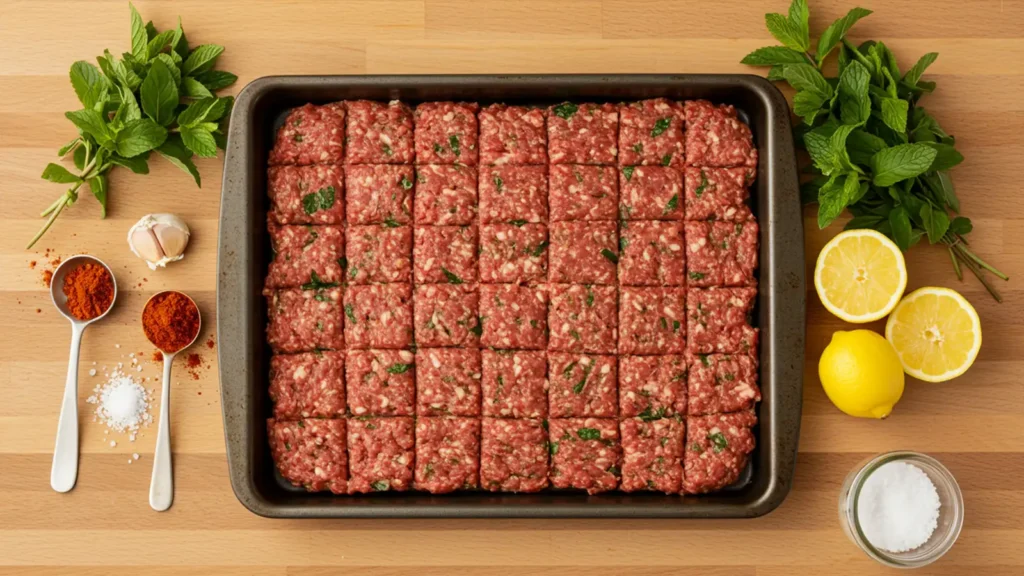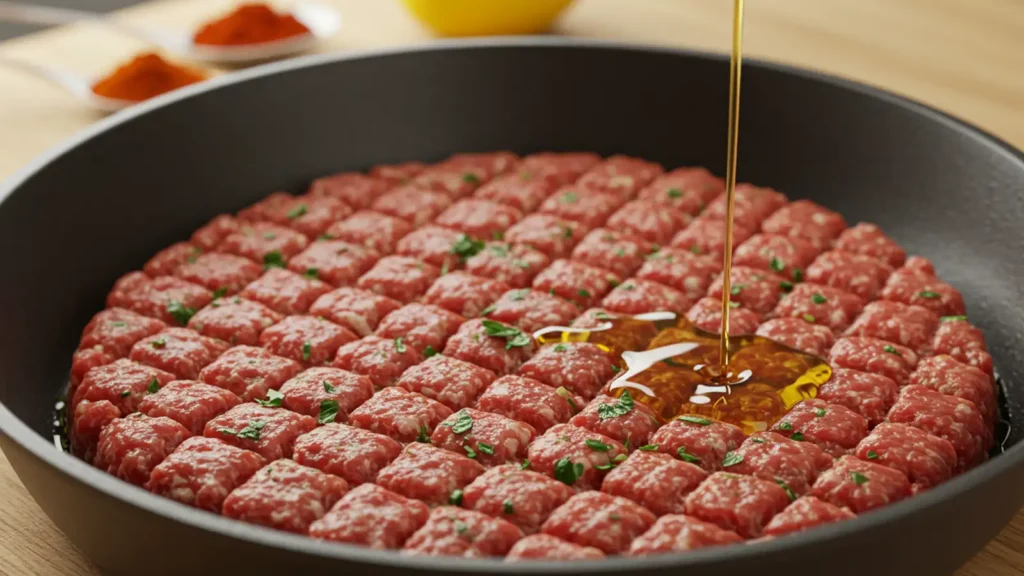Baked kafta has won the hearts of those who want practicality without giving up flavor. Unlike the traditional skewer version, this recipe is made directly in the baking pan, which makes the preparation quicker and simpler.
The meat is seasoned with an engaging combination of spices, fresh herbs, and a citrus touch that brings out every aroma. After being shaped and baked, it develops a lightly golden crust on the outside while staying incredibly tender on the inside.
Besides being practical, baked kafta pairs beautifully with different sides: from lentil rice to roasted vegetables, golden potatoes, or even pita bread with sauce. It’s a perfect choice for everyday meals and also for special lunches.
Index – Straight to the Point
Baked kafta recipe
Here is the traditional base for baked kafta—easy to prepare and full of flavor. This recipe yields about four generous servings and can easily be doubled for larger gatherings.
Ingredients
- 600 g (about 1.3 lb) lean ground beef (round)
- 1 tsp smoked paprika
- 1 tsp onion powder
- 1 tsp garlic powder
- 1 tsp ground ginger
- 1 tsp garam masala
- Zest of 1 lemon
- 1 handful chopped parsley
- 1 handful chopped mint
- 1 level tbsp salt (per 1 kg / 2.2 lb of meat)
- Olive oil for greasing and drizzling
How to make
- In a large bowl, add the ground beef and all the dry spices: paprika, onion powder, garlic powder, ground ginger, and garam masala.
- Mix well until the spices are fully incorporated into the meat.
- Add the lemon zest, parsley, and chopped mint. These ingredients bring freshness and enhance the flavor of baked kafta.
- Add the salt and mix again—preferably with your hands—to ensure the meat absorbs all the aromas.
- Grease a baking pan with olive oil and spread the meat evenly, about one finger thick.
- With a spatula or the tip of a knife, make small marks on the surface, creating diamond or rectangle patterns.
- Drizzle with olive oil and bake in a preheated oven at 200°C (392°F) for about 20 minutes, or until lightly golden.
- Remove from the oven and serve immediately with the sides of your choice.

Golden tips for the best baked kafta
Baked kafta may look simple, but a few details make all the difference to reach the perfect point. Check out these practical, foolproof tips:
- Choose the right meat: round is a great option, but you can mix in chuck or flank for extra juiciness.
- Don’t make it too thick: the thicker the layer, the longer it will take to bake and the higher the risk of drying out.
- Marinate the meat: if you have time, let the meat and spice mixture rest in the fridge for 30 minutes before baking. This intensifies the flavor.
- Drizzle with olive oil: the oil helps form a golden crust and prevents baked kafta from sticking to the pan.
- Avoid overmixing: working the meat too much can make the texture dense and less juicy.
- Serve with cool sauces: yogurt, tahini, or mint sauces balance the spice profile.
These small steps turn a simple recipe into a restaurant-worthy dish, with an irresistible aroma and enveloping flavor.

Yogurt and mint sauce: the perfect side
Nothing pairs better with baked kafta than a refreshing yogurt and mint sauce. It contrasts the spices with the light acidity and freshness of plain yogurt.
Sauce ingredients
- 1 container plain yogurt
- 1 tbsp olive oil
- Juice of half a lemon
- 1 tbsp finely chopped mint
- Salt and pepper to taste
How to make
Mix all ingredients in a bowl until smooth and creamy. Adjust salt and acidity to taste. Chill the sauce for a few minutes before serving.
This sauce is excellent for drizzling over baked kafta, dipping pita bread, or accompanying light salads.
Caramelized onions: the sweet touch that transforms
Another amazing pairing is caramelized onions, which bring a gentle, sweet contrast to the bold spices in baked kafta.
Ingredients
- 2 large onions, thinly sliced
- A drizzle of olive oil
- A pinch of salt
- 1 tsp brown sugar (optional)
- A splash of water as needed
How to make
Heat a skillet with olive oil and add the onions. Cook over low heat, stirring often. Add small splashes of water to deglaze the pan as needed. The process takes about 20 minutes, until the onions are golden and soft.
The combination of baked kafta with caramelized onions and yogurt sauce is simply irresistible.

The origin of kafta and its oven-baked version
Kafta is a traditional dish from Arab cuisine, originally shaped on skewers and grilled over coals. Its name comes from the term “kofta,” which means “paste” or “meatball” in Arabic. This preparation spread across many Middle Eastern countries and gained variations around the world.
Baked kafta is a modern adaptation that keeps the authentic flavor while simplifying the process. Instead of shaping each piece on a skewer, the meat is spread in a baking pan and baked, resulting in a more practical yet equally delicious dish.
This technique has become popular especially among those seeking quick, homemade meals without losing the essence of traditional Arab seasoning.
Variations of the baked kafta recipe
One of the great advantages of baked kafta is its versatility. You can adapt the spices and ingredients according to your taste or whatever you have in the fridge.
Meat variations
- Beef with lamb: adds a more robust and traditional flavor.
- Ground chicken: creates a lighter version, ideal for warmer days.
- Pork: makes the dish juicier with a slightly sweet note.
Seasoning variations
- Swap garam masala for cumin and nutmeg.
- Add baharat (Syrian pepper blend) for a more authentic touch.
- Include dried mint for an even more intense aroma.
Preparation variations
- Try baking with tomato and onion slices on top.
- Use a skillet for a quick, golden sear.
- Turn the mixture into mini kaftas to serve as appetizers.
These variations show how baked kafta can adapt to different meal styles without losing its charm.
Side dish suggestions
Baked kafta pairs with a variety of sides that complete the dish harmoniously. Here are some ideas:
- Lentil rice with crispy onions
- Moroccan couscous with vegetables
- Tomato, cucumber, and mint salad
- Pita bread with hummus
- Roasted potatoes with rosemary
- Traditional tabbouleh
These sides add complementary textures and flavors, making for a balanced, fresh meal.
Storage and reuse
If you have leftover baked kafta, store it for up to 3 days in the refrigerator in an airtight container. When reheating, pop it back in the oven for a few minutes to keep it juicy.
Another idea is to use cold pieces to make sandwiches, wraps, or savory pie fillings. Just add a bit of sauce and fresh greens and you’ll have a new, delicious meal.
FAQ – common questions about baked kafta
1. Can I freeze baked kafta while still raw?
Yes. Prepare the mixture, spread it in the baking pan, and cover with plastic wrap. Freeze. When ready to bake, place it straight into the oven.
2. What’s the best meat for kafta?
Lean beef (round) is great, but mixing in fattier cuts like chuck or flank gives a moister texture.
3. Is garam masala necessary?
It’s not mandatory, but it lends a special Eastern profile. You can substitute cumin and baharat (Syrian pepper blend).
4. Is mint essential?
Yes, it’s one of the secrets of baked kafta. It adds unique freshness and aroma.
5. Can I make individual portions?
Absolutely! Shape into small logs or skewers and bake the same way. They’re great as appetizers.
Conclusion: a simple dish that charms
Baked kafta proves that a simple recipe can taste like a celebration. With few ingredients, you can create an aromatic, balanced dish full of personality.
It’s perfect for anyone who wants to refresh the weekly menu, surprise guests, or simply enjoy a delicious homemade meal.
With the tips and sides in this article, your baked kafta will come out of the oven golden, juicy, and irresistible—a true crowd-pleaser.
READ ALSO:
- Zucchini Stuffed with Ground Beef
- Homemade Cappuccino: Learn the Best At-Home Recipe
- Learn to Make Delicious Stuffed Polpettone
JOIN OUR GROUP